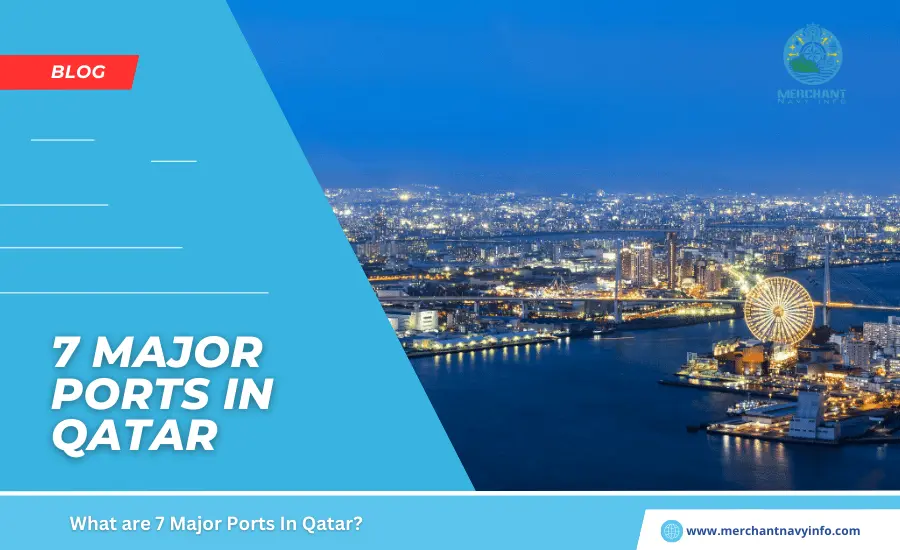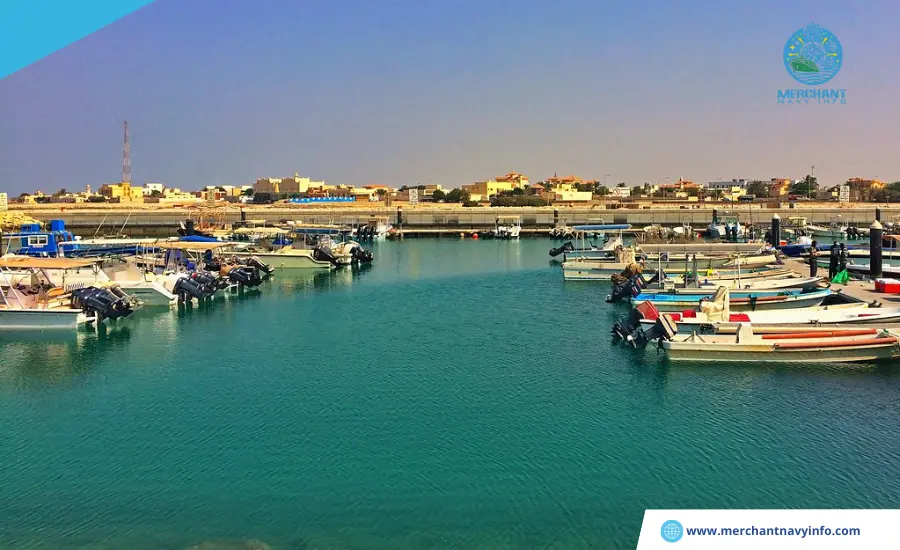
The nation-state of Qatar is known as a highly developed economy with one of the highest GDPs in the world. Its economic prosperity is dependent on the oil. Natural gas and petroleum industries, with the country being the world’s largest LNG exporter. Its main trading partners are China, also the United States. Europe Japan, and the world’s largest shipping companies operate in almost all of Qatar’s ports and terminals. The country boasts negligible unemployment, its citizens enjoy a high standard of living, and also poverty rates are virtually non-existent. Low taxes make it easy to do business, attracting foreign companies. As the country shares a significant area with the Persian Gulf, it has invested in developing world-class port facilities. With the opening of new trade routes and diversification of supply sources. Its maritime trade sector has been strengthened many fold.
Major Ports In Qatar
1. Hamad Port/Doha

Hamad Port is the most important Qatar port and is located south of Doha. The construction of this port began in 2010, and commercial trade began in 2016. It replaced the old Doha Port. It is operated and managed by the Muwani. Qatar and overseen by the Ministry of Transport and Communications. It mainly handles general cargo as well as special imports such as livestock, vehicles and grains. It is one of the largest ports in the Middle East and represents Qatar’s National Vision 2030. The port is crucial to the country’s shipping trade industry and Qatar’s socio-economic development. Port activities and construction aim to diversify the economy and strengthen competitiveness and international trade while attracting foreign investors.
Container Terminals
Hamad Port has three container handling facilities with a combined capacity of handling more than 7 million TEUs per year. All terminals are equipped with the latest Qatar port equipment. Including shipboard cranes and state-of-the-art gantry cranes for efficient cargo handling. The facilities are also equipped with the latest container scanning technology, which significantly reduces container handling times.
General Cargo Handling Facility
A facility that handles all non-container cargo, including machinery. Steel and steel products, dry bulk cargo, construction equipment, fertilizer, and petroleum products. It has ample storage space, including sheds, reinforced covered storage rooms, and refrigerated warehouses, and can handle approximately 1.6 million tons.
Multipurpose Terminal
This terminal is divided into smaller units or also facilities to handle specific goods such as grain, livestock, and automobiles. The grain handling facility is equipped with automatic loading and unloading. Conveyors that unload grain directly into silos, eliminating the need for personnel. This automobile terminal handles the shipment of more than 450,000 vehicles per year. The livestock terminal consists of several automated gates that separate different types of livestock. The port has a world-class security system, including a 110-meter-tall port tower and a customs-controlled area that handles over 5,500 containers in 24 hours. Hamad Port also offers ship repair and inspection facilities, as well as a number of maritime services. As Qatar planned to increase its non-oil exports, a production base zone was established near the port.
2. Ras Laffan Port

Located on the northeast coast of Qatar, this Qatar port is the world’s largest liquefied natural gas (LNG) export facility. It can accommodate the largest shipping vessels. It is a deep-water port with the world’s largest artificial harbor, strategically located between the Arabian Gulf, the Far East, and also Europe on the international maritime trade route, from which hydrocarbon products are transported to almost all major regions of the world.
Ras Laffan Port was built primarily for the natural gas industry, which produces gas products and their derivatives. The port is spread over 850 hectares, surrounded by two breakwaters and two entrance channels, and dredged to a depth of 14.5 m. It handles liquefied petroleum gas, petroleum products, sulfur, etc., and handles more than 1,000 ships and more than 10 million tons of cargo annually. It is owned and also operated by Qatar Petroleum.
LNG Handling Facilities
Ras Laffan Port has six LNG handling facilities capable of accommodating the largest LNG tankers with a loading capacity of more than 200,000 cubic meters. The remaining four berths handle mid-sized LNG tankers with a cargo capacity of more than 220,270 cubic meters.
Liquid Bulk Goods
Transshipment Facilities Six such facilities are operational for the transshipment of liquid bulk goods such as liquid gas and refined products. They can accommodate vessels between 165 and 345 meters in length.
Sulfur Terminal
The docks in the Ras Laffan port area are designed specifically for handling sulfur and can handle vessels of over 100,000 DWT.
Conventional Cargo Terminal
The Qatar port has four dry cargo berths, each 300 m long and capable of handling vessels of over 60,000 DWT. Two berths are equipped with RoRo facilities, 150 m long, and capable of accommodating vessels of around 20,000 DWT. The port has 14 berths offshore, providing numerous services such as bunkering and clean water. It also has three separate offshore berths located just 55 km from the main port area, capable of handling vessels of between 90,000 and 325,000 DWT.
Ras Laffan Shipyard
This modern shipyard is spread over 110 hectares and has made Ras Laffan Port one of the world’s most prestigious facilities for the repair, maintenance and construction of ships. It includes two huge and spacious quays, large enclosed production units, assembly rooms, numerous warehouses and administrative offices.
3. Al Ruwan Port

Al Ruwan Port is the second most important commercial Qatar port. Located at the northern tip, the port facilities have played a vital role in the growth and diversification of cargo traffic in the region and have boosted the economy of northern Qatar by significantly improving and increasing the volume of maritime trade. In addition to handling traditional cargo, Al Ruwai Port also caters to the growing demand for food, canned goods, meat, and other raw materials by acting as a maritime gateway for efficient and fast distribution of fresh and chilled produce from neighboring countries.
To this end, a new system for handling refrigerated containers has been built and expanded. Mwani The Qatari-operated port has undergone significant infrastructure development to meet global port standards and improve port productivity. The entrance canal has been dredged to 5 m, and a new quay with a long side depth of 7 m has been constructed.
4. Mesaieed Port/Umm Said Mesaieed

Port, also known as Umm Said Port, is located on the east coast of Qatar, just 45 km south of Doha. The port is located in the industrial region of the country and is one of the most important ports in Qatar. The port handles around 2,800 vessels, 48 million tons of cargo, and 59,000 TEU annually. Port handles a variety of cargoes, including exports such as crude oil, refined products, liquefied petroleum gas, naphtha, petrochemicals, ethylene, ammonia, methanol, polyethylene pellets, urea, iron and steel, sulfur, bulk cargoes, conventional cargoes.
Imports handled at the port include iron ore pellets, salt, cement, clinker, project cargoes, etc. The port has 29 operational berths for handling special cargoes. The three gabbro berths handle clinker, gabbro, and conventional cargoes and can accommodate vessels weighing more than 90,000 DWT and with a maximum width of more than 60 m.
5. Al Rayyan Oil Terminal Port

Al Rayyan Marine Terminal is located in the southern part of the Persian Gulf, just 35 nautical miles from the north coast of Qatar port. The terminal consists of a 124,472 DWT or VLCC-size storage tanker named Falcon Spirit, an FSO moored at one location. Many export tankers are anchored close to the storage tanker, which receives crude oil through a pipeline connected to a large production unit near the terminal. The terminal area can accommodate tankers up to 320,000 DWT in size, but the maximum draft of the vessels does not exceed 21 m.
6. Al Shaheen Oil Terminal

The facility is located near the Shaheen oil field off the northeast coast of Qatar. It is the country’s largest offshore oil field and also one of the largest in the world. Produces 100 million barrels of oil per year and contributes to 45% of Qatar’s oil production. It has 33 platforms and also more than 300 wells. The terminal facility is operated by North Oil Company and consists of two FSOs, FSO Africa and Asia, which are moored at SPM, where they transship crude oil to export tankers.
7. Port of Harul Island

Harul Island belongs to Qatar and is just 52 nautical miles from Doha. The island’s port facilities serve as the export terminal for Qatar’s offshore crude oil extracted from northern fields such as Eid el-Shargi. The Qatar Petroleum-operated facility is operated by two SBMs for export activities. The island is circular, has an extensive coral reef, and is highly rugged. Parts of the island house oil tanks as well as industrial parks and worker housing.









